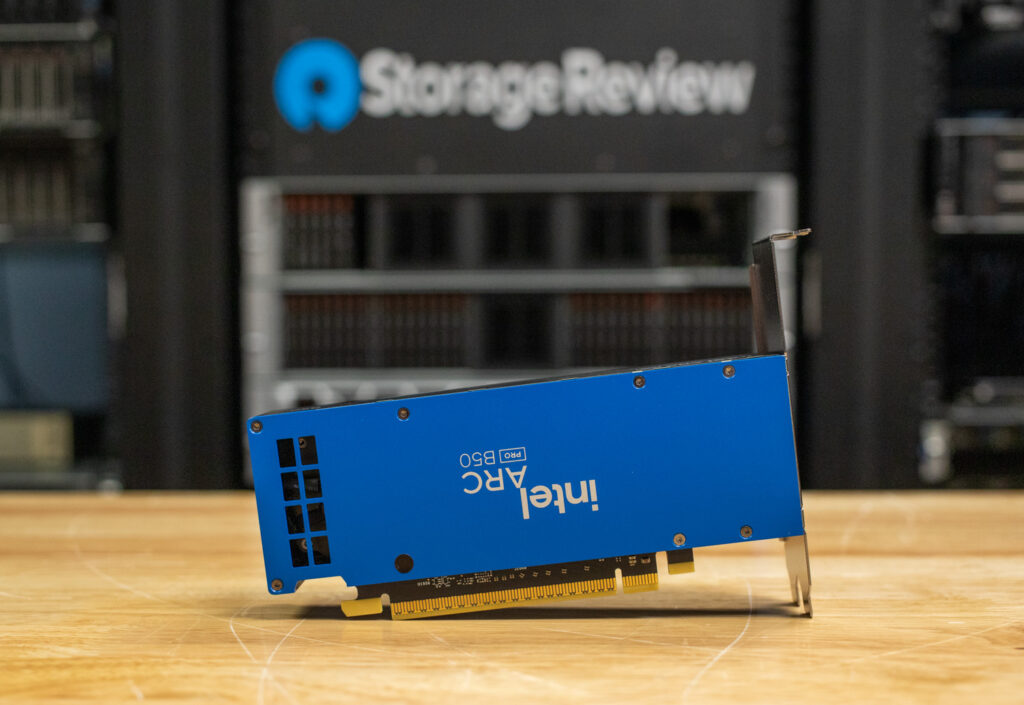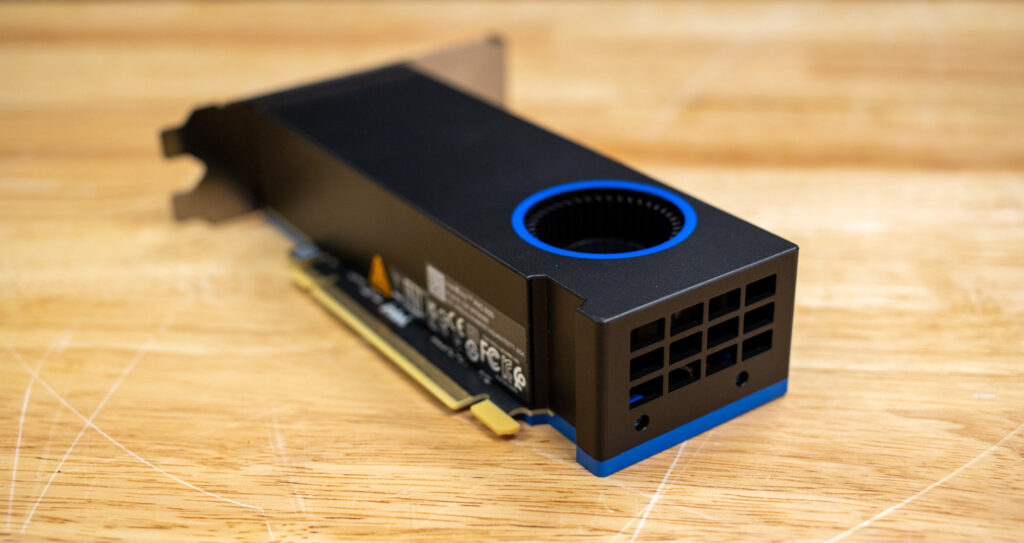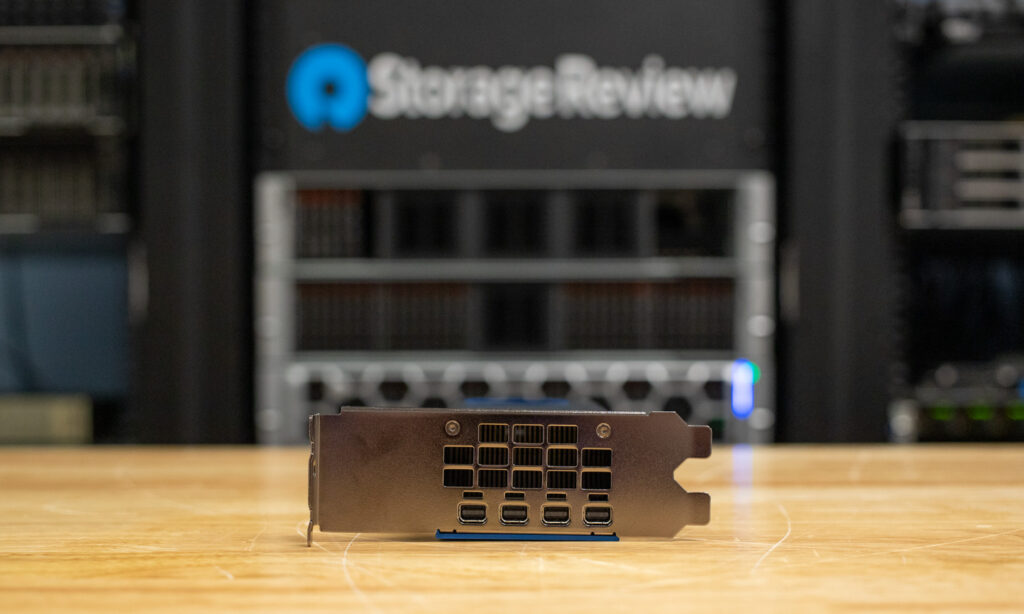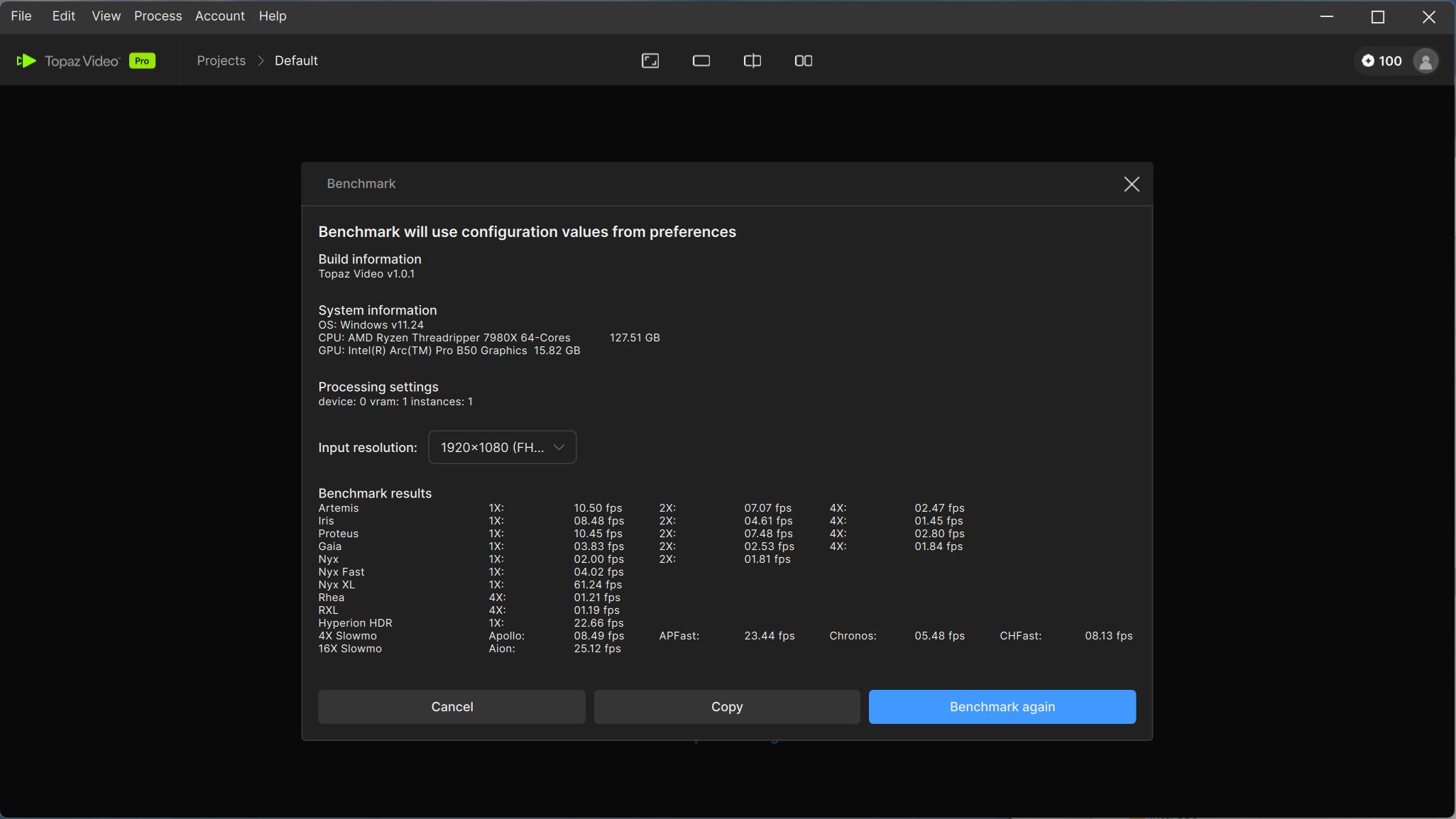Intel’s Arc Pro B50 GPU marks another meaningful milestone in the company’s steady expansion into professional graphics. For years, Intel’s GPU ambitions have existed in two parallel tracks: gaming-focused Arc cards for consumers and workstation-oriented Arc Pro products for creators, engineers, and developers. The B-series continues the latter effort, building on lessons learned from the Arc Pro A-series and carrying forward design, driver, and software improvements aimed squarely at professional workloads rather than gaming benchmarks.

The Arc Pro B-series currently consists of two models, the B50 and B60, each designed for reliability, ISV certification, and predictable performance in CAD, visualization, simulation, and AI-assisted workflows. The B50 serves as an efficient entry point: a compact, low-power GPU designed for small-form-factor systems and professionals who require dependable acceleration without the power draw or thermal demands of higher-end cards. The B60, with more cores, higher memory bandwidth, and VRAM, builds on that foundation for larger datasets, heavier inference workloads, or multi-GPU workstations such as Intel’s own Battlematrix reference platform.
While NVIDIA remains the clear leader in the professional GPU market, and AMD continues to compete effectively on price-to-performance, Intel’s approach with the Arc Pro B50 isn’t about trying to displace either overnight. Instead, it’s about providing a credible, standards-based alternative built around power efficiency, stable drivers, and broad application compatibility through Intel’s oneAPI ecosystem. The B50 also benefits indirectly from the company’s growing experience with Intel’s Gaudi enterprise AI accelerators, where architectural improvements in memory efficiency and compute scaling inform the design philosophy of this generation.
It’s worth noting that despite the similar naming, the Arc Pro B-series is distinct from Intel’s Arc B-series gaming GPUs. The gaming line targets enthusiasts and mainstream players seeking performance for their dollar, while the Arc Pro B-series emphasizes certified stability, extended lifecycle support, and professional-grade driver tuning. In short, the B50 isn’t built for gaming sessions; it’s built for work.
For creative professionals, engineers, and developers working across mixed workloads spanning design visualization, AI inference, and GPU-accelerated computation, the Intel Arc Pro B50 offers a pragmatic balance of efficiency, reliability, and cost. With a street price of around $349, it’s a card that makes sense for users who value consistency and professional integration over chasing the top of the performance charts.
Intel Arc Pro B50 Design and Build
Looking at the hardware itself, the Arc Pro B50 features a compact, low-power design suitable for small workstations and embedded platforms, measuring 6.6 inches in length and 2.7 inches in width. It utilizes a half-height bracket, allowing it to fit into systems with limited space, such as small-form-factor workstations or embedded environments. The card weighs 330 grams and is passively cooled, relying on system airflow rather than an onboard fan. This design avoids additional thermal load, but may require planning for chassis airflow depending on the deployment.

The B50 draws power (70 watts TPD) through the PCIe slot and doesn’t require any external connectors. This can simplify integration in prebuilt or OEM systems, especially where cable routing or power headroom is limited. Intel recommends a minimum 280 W power supply for systems using this card.
The Arc Pro B50 is built on Intel’s Xe2 architecture and manufactured using TSMC’s 5nm process. It features 16 Xe cores and four render slices, with 128 vector engines for general-purpose compute and 128 XMX engines for AI workloads, spread across the GPU. There are also 16 dedicated ray tracing units built into the architecture. The card runs at a base clock of 1700 MHz and can boost up to 2600 MHz when needed. Peak compute performance is 10.65 TFLOPS (FP32) and 170 TOPS for INT8, which is typically used in AI inference.

It comes with 16GB of GDDR6 memory running on a 128-bit bus. While that’s a narrower interface than what you’d find on high-end GPUs, it’s paired with 14Gbps memory modules, which pushes total bandwidth to 224 GB/s. For many professional tasks, such as working with large textures in 3D models, multi-layered video timelines, or local AI inference, this provides enough bandwidth to keep most tasks running smoothly. The card connects via a PCIe 5.0 x8 interface (and is compatible with older PCIe generations), which provides more than enough bandwidth for typical professional workloads in Gen5 systems.

The B50 features four full-featured DisplayPort 2.1 outputs, enabling up to four monitors to be displayed simultaneously. It supports resolutions up to 8K at 60 Hz, or multiple 4K displays, without bandwidth issues. These ports also support UHBR 13.5. This means higher data rates are available for high-refresh or high-resolution panels, which is especially useful for display clarity and color depth. On the media side, the card features full hardware acceleration for standard codecs, including H.264, H.265, VP9, and AV1, as well as Dolby Vision playback support. For applications and frameworks, it covers all the usual APIs—DirectX 12 Ultimate, Vulkan 1.4, OpenGL 4.6, and OpenCL 3.0. The card supports Intel’s oneAPI, OpenVINO, XeSS, and the PyTorch IPEX extension, all of which are designed to improve performance in AI and machine learning workloads.
Intel Arc Pro B50 Specifications
| Specification | Detail |
|---|---|
| GPU Architecture | Xe2 (TSMC N5) |
| Xe-cores | 16 |
| Render Slices | 4 |
| Ray Tracing Units | 16 |
| XMX Engines | 128 |
| Vector Engines | 128 |
| Graphics Base Clock | 1700 MHz |
| Max Dynamic Clock | 2600 MHz |
| GPU FP32 Performance | 10.65 TFLOPS |
| GPU Peak TOPS (INT8) | 170 |
| Total Board Power (TBP) | 70 W |
| Memory | 16 GB GDDR6 |
| Memory Interface | 128-bit |
| Memory Bandwidth | 224 GB/s |
| Memory Speed | 14 Gbps |
| PCIe Interface | PCIe 5.0 x8 |
| Display Outputs | 4x DisplayPort 2.1 (UHBR 13.5) |
| Max Resolution | 7680 x 4320 @ 60Hz |
| H.264 / H.265 / AV1 / VP9 Support | Yes |
| API Support | DirectX 12 Ultimate, Vulkan 1.4, OpenGL 4.6, OpenCL 3.0 |
| oneAPI / OpenVINO Support | Yes |
| PyTorch IPEX Extension | Yes |
| Intel XeSS Support | Yes |
| Form Factor | 6.6″ x 2.7″, Dual-slot |
| Weight | 330 g |
| Power Connector | None (powered via PCIe slot) |
| Minimum PSU | 280 W |
| Warranty | 3 years |
| Launch Date | Q3 2025 |
Intel Arc Pro B50 Performance
Performance testing focuses on how the Arc Pro B50 handles real-world workloads across AI inference, image generation, rendering, and compute-heavy applications.
UL Procyon: AI Text Generation
The Procyon AI Text Generation Benchmark streamlines AI LLM performance testing by providing a concise and consistent evaluation method. It allows repeated testing across multiple LLM models while minimizing the complexity of large models and variable factors. Developed with AI hardware leaders, it optimizes the use of local AI accelerators to deliver more reliable, efficient performance assessments. The following results were measured using TensorRT on NVIDIA models and ONNX on AMD models.
The Arc Pro B50 performs well for its class, ranking ahead of AMD’s RX 9060 XT and 9070, while staying competitive with the RTX 5060 Ti in overall scores. Its biggest strength is response time, as it consistently returned the fastest time-to-first-token across models. Token throughput is lower than NVIDIA’s newer cards. However, for tasks like light inference or design tools with AI features, the B50 is a great option for those without high-end hardware.
| UL Procyon: AI Text Generation | Intel Arc Pro B50 | AMD Radeon RX 9060 XT | AMD Radeon RX 9070 | AMD Radeon RX 9070 XT | NVIDIA GeForce RTX 5060 Ti | NVIDIA GeForce RTX 5070 FE |
| Phi Overall Score | 2,593 | 1,281 | 1,933 | 2,080 | 2,870 | 3,453 |
| Phi Output Time To First Token | 0.275 s | 1.473 s | 0.954 s | 0.855 s | 0.375 s | 0.323 s |
| Phi Output Tokens Per Second | 72.128 tokens/s | 94.453 tokens/s | 139.187 tokens/s | 144.471 tokens/s | 120.773 tokens/s | 150.435 tokens/s |
| Phi Overall Duration | 39.179 s | 39.365 s | 26.989 s | 25.587 s | 25.216 s | 20.302 s |
| Mistral Overall Score | 2,483 | 1,274 | 2,040 | 2,231 | 2,807 | 3,562 |
| Mistral Output Time To First Token | 0.346 s | 1.827 s | 1.109 s | 0.946 s | 0.526 s | 0.433 s |
| Mistral Output Tokens Per Second | 46.799 tokens/s | 65.115 tokens/s | 101.300 tokens/s | 103.348 tokens/s | 91.057 tokens/s | 120.507 tokens/s |
| Mistral Overall Duration | 59.907 s | 54.516 s | 34.960 s | 33.350 s | 33.377 s | 25.496 s |
| Llama3 Overall Score | 2,427 | 1,150 | 1,904 | 2,070 | 2,599 | 3,125 |
| Llama3 Output Time To First Token | 0.311 s | 1.632 s | 0.981 s | 0.845 s | 0.449 s | 0.379 s |
| Llama3 Output Tokens Per Second | 145.031 tokens/s | 53.167 tokens/s | 87.594 tokens/s | 89.102 tokens/s | 74.709 tokens/s | 100.388 tokens/s |
| Llama3 Overall Duration | 61.926 2 | 62.563 s | 38.273 s | 36.742 s | 39.489 s | 29.720 s |
| Llama2 Overall Score | – | 1,252 | 2,047 | 2,298 | 2,576 | 3,125 |
| Llama2 Output Time To First Token | – | 2.992 s | 1.926 s | 1.565 s | 0.844 s | 0.785 s |
| Llama2 Output Tokens Per Second | – | 34.654 tokens/s | 59.673 tokens/s | 61.127 tokens/s | 41.386 tokens/s | 56.647 tokens/s |
| Llama2 Overall Duration | – | 99.027 s | 59.100 s | 55.520 s | 71.302 s | 53.234 s |
UL Procyon: AI Image Generation
The Procyon AI Image Generation Benchmark consistently and accurately measures AI inference performance across a range of hardware, from low-power NPUs to high-end GPUs. It includes three tests: Stable Diffusion XL (FP16) for high-end GPUs, Stable Diffusion 1.5 (FP16) for moderately powerful GPUs, and Stable Diffusion 1.5 (INT8) for low-power devices. The benchmark uses the optimal inference engine for each system, ensuring fair and comparable results.
Image-generation performance illustrates the B50’s limitations. That said, it completed every test without issue, and the INT8 results show it can handle optimized inference models when needed. It’s not ideal for frequent image generation, but it’s serviceable for lighter or occasional AI graphics tasks.
| UL Procyon: AI Image Generation (overall score: higher is better) | Intel Arc Pro B50 | AMD Radeon RX 9070 XT | NVIDIA GeForce RTX 5060 Ti | AMD Radeon RX 9070 | AMD Radeon RX 9070 XT | NVIDIA GeForce RTX 5070 FE |
| Stable Diffusion 1.5 (FP16) — Overall Score | 754 | 1,436 | 2,110 | 2,280 | 2,598 | 2,937 |
| Stable Diffusion 1.5 (FP16) — Overall Time | 132.585 s | 69.633 s | 47.590 s | 43.858 s | 38.481 s | 34.038 s |
| Stable Diffusion 1.5 (FP16) — Image Generation Speed | 8.287 s/image | 4.352 s/image | 2.974 s/image | 2.741 s/image | 2.405 s/image | 2.127 s/image |
| Stable Diffusion 1.5 (INT8) — Overall Score | 5,020 | N/A | 27,705 | N/A | N/A | 36,320 |
| Stable Diffusion 1.5 (INT8) — Overall Time | 49.795 s | N/A | 9.024 s | N/A | N/A | 6.883 s |
| Stable Diffusion 1.5 (INT8) — Image Generation Speed | 6.224 s/image | N/A | 1.128 s/image | N/A | N/A | 0.860 s/image |
| Stable Diffusion XL (FP16) — Overall Score | 748 | 1,124 | 1,940 | 1,805 | 2,010 | 2,473 |
| Stable Diffusion XL (FP16) — Overall Time | 790.774 s | 533.736 s | 326.550 s | 332.400 s | 298.499 s | 242.606 s |
| Stable Diffusion XL (FP16) — Image Generation Speed | 49.423 s/image | 33.359 s/image | 20.409 s/image | 20.775 s/image | 18.656 s/image | 15.163 s/image |
Luxmark
Luxmark is a GPU benchmark that uses LuxRender, an open-source ray-tracing renderer, to assess a system’s performance with highly detailed 3D scenes. This benchmark is particularly relevant for evaluating the graphical rendering capabilities of servers and workstations, especially in visual effects and architectural visualization applications, where accurate light simulation is crucial.
In LuxMark, the B50 results were well below midrange GPUs like the 5060 Ti or RX 9070, which isn’t unexpected. It’s capable of completing ray-traced workloads, but render speeds are limited.
| Luxmark (higher is better) | Intel Arc Pro B50 | AMD Radeon RX 9060 XT | NVIDIA GeForce RTX 5060 Ti | AMD Radeon RX 9070 | AMD Radeon RX 9070 XT | NVIDIA GeForce RTX 5070 FE |
| Food Score | 2,456 | 4,220 | 6,590 | 8,233 | 8,610 | 9,061 |
| Hall Score | 5,158 | 8,007 | 15,348 | 16,566 | 16,758 | 22,062 |
Geekbench 6
Geekbench 6 is a cross-platform benchmark that measures overall system performance. The Geekbench Browser allows you to compare any system to it.
At just over 70,000, it performed as expected from a lower-power, compact GPU. It’s not built for heavy compute tasks or simulation work, but for basic GPU acceleration in CAD and pro apps, the performance is decent.
| Geekbench (higher is better) | Intel Arc Pro B50 | AMD Radeon RX 9060 XT | AMD Radeon RX 9070 | NVIDIA GeForce RTX 5060 Ti | NVIDIA GeForce RTX 5070 FE | AMD Radeon RX 9070 XT |
| GPU OpenCL Score | 70,038 | 102,750 | 138,463 | 150,743 | 173,255 | 188,892 |
3DMark
3DMark Port Royal, Speed Way, and Steel Nomad are GPU benchmarks that test performance across different scenarios. Port Royal focuses on ray tracing, Speed Way evaluates performance in racing simulations, and Steel Nomad challenges GPUs with high-intensity, realistic graphics. They assess GPU capabilities in rendering, lighting, and dynamic scenes.
3DMark results are well below the entry-level gaming GPU comparables. But again, this was expected. It aligns with its role in workstations, where stability and power efficiency are more than frame rates or real-time rendering.
| 3DMark (higher is better) | Intel Arc Pro B50 | AMD Radeon RX 9060 XT | NVIDIA GeForce RTX 5060 Ti | NVIDIA GeForce RTX 5070 FE | AMD Radeon RX 9070 | AMD Radeon RX 9070 XT |
| Port Royal | 4,197 | 9,751 | 10,432 | 14,026 | 15,760 | 17,989 |
| Speed Way | 1,355 | 3,004 | 4,184 | 5,869 | 5,791 | 6,237 |
| Steel Nomad | 1,644 | 3,767 | 3,611 | 5,019 | 5,992 | 6,977 |
Topaz Video AI
Topaz Video AI is a professional application for enhancing and restoring video using advanced AI models. It supports various tasks, including upscaling footage to 4K or 8K, sharpening blurry content, reducing noise, enhancing facial details, colorizing black-and-white footage, and interpolating frames for smoother motion. The suite includes an onboard benchmark that measures system performance across its different video-enhancing algorithms, giving a clear view of how well hardware platforms handle demanding AI video processing workloads.
In Topaz, the Intel Arc Pro B50 delivered modest performance, aligning with expectations for a low-power, slot-powered workstation GPU.
In the Artemis model, it achieved 10.50 fps at 1× and dropped to 2.47 fps at 4×, indicating that while it can handle basic enhancement or denoising tasks, heavier upscaling quickly strains the GPU. The Iris and Proteus models performed similarly, with around 8–10 fps at 1× and under 3 fps at 4×, reflecting the card’s limited compute headroom for AI-driven workloads.
More demanding pipelines, such as Nyx, Rhea, and RXL, hovered below 2 fps, confirming that the Arc Pro B50 isn’t designed for large-scale temporal or multi-frame processing. Lighter models, such as Apollo and Aion, reached 8.49 fps and 25.12 fps, respectively, demonstrating better efficiency when effects are less GPU-intensive.
Overall, the Arc Pro B50 is functional for lighter 1080p video enhancement tasks, but it is underpowered for serious upscaling or AI-assisted restoration. It’s best suited for occasional preview or light batch work rather than heavy production use.

GeekBench
Geekbench 6 is a cross-platform benchmark that measures overall system performance.
The Intel Arc Pro B50 delivered modest performance across Blender’s test scenes, aligning with expectations for a card that draws all of its power directly from the PCIe bus.
In the Monster scene, the card reached 738.16 samples per minute, a reasonable figure that shows it can handle medium-complexity geometry and shading workloads without relying on external power. Still, the performance sits below what you’d expect from higher-wattage workstation GPUs.
The Junkshop scene proved more challenging, where the Arc Pro B50 managed 405.23 samples per minute. This test stresses texture density and ray tracing, and the results suggest bandwidth and compute limitations inherent to the card’s lower power envelope.
In the Classroom scene, the GPU produced 414.62 samples per minute, maintaining consistent rendering stability but again falling short of more robust, actively powered options.
| Blender Benchmark (samples per minute, higher is better) | Blender 4.3.0 | Blender 4.4.0 | Blender 4.5.0 |
| Monster | 632.94 | 650.88 | 738.16 |
| Junkshop | 293.15 | 344.19 | 405.23 |
| Classroom | 329.82 | 358.63 | 414.62 |
Power Consumption: Intel B50
Power consumption is a significant component of any high- or low-end computing platform. Each new generation of GPU consumes more power under load, meaning larger power supplies and ample airflow for cooling. However, there is another aspect to power regarding performance: faster GPUs might spike higher, but the duration of each workload decreases. Leveraging the Quarch Mains Analyzer in our test lab, we measured the total system power consumed while running the Procyon AI Image Generator Stable Diffusion XL FP16 test. This workload pushed each GPU to its power limits, with defined start and stop points for each generated image being readily visible.
In the test, the Intel Arc Pro B50 has the lowest power consumption of all cards tested at 70W. While the Procyon AI image-generating test was running, the system’s power consumption increased from a background level of 151W to an average load of 384W. We measured a peak power consumption of the system of 586W. The time to generate the second-to-last image was measured at 49.9 seconds, and 5.32 Wh was used during that period. While the Intel Arc Pro B50 is designed to draw a low amount of power from the PCIe slot itself, it does use more power over the duration required to generate an image in this test.
| Stable Diffusion XL FP16 Image Power Used (lower is better) | Intel Arc Pro B50 | AMD Radeon RX 9070 | AMD Radeon RX 9070 XT | PNY NVIDIA GeForce RTX 5060 Ti | NVIDIA GeForce RTX 5070 FE |
| Power Consumed | 5.32 Wh | 4 Wh | 3.41Wh | 2.13 Wh | 2.46Wh |
| Test Duration | 49.9 s | 33 s | 17.4 s | 20.2 s | 19.2 s |
Conclusion
The Arc Pro B50 is not aiming to be the fastest card in the professional GPU market. Instead, it delivers reliable performance, stable drivers, and broad application support in a compact, power-efficient form factor. It handled every workload in our testing without instability or thermal concerns, and its compact footprint makes it an easy fit for existing workstations that cannot accommodate larger or higher-wattage GPUs.

For professionals working in CAD, design visualization, or AI-assisted applications that require predictable performance and compatibility rather than maximum throughput, the B50 is a practical and cost-effective option. At around $349, it offers a clear value proposition for small form factor builds, OEM integrations, and labs deploying multiple workstation nodes. If your priority is quiet, dependable acceleration that integrates seamlessly into professional workflows, the Arc Pro B50 is a smart and sensible choice.




 Amazon
Amazon